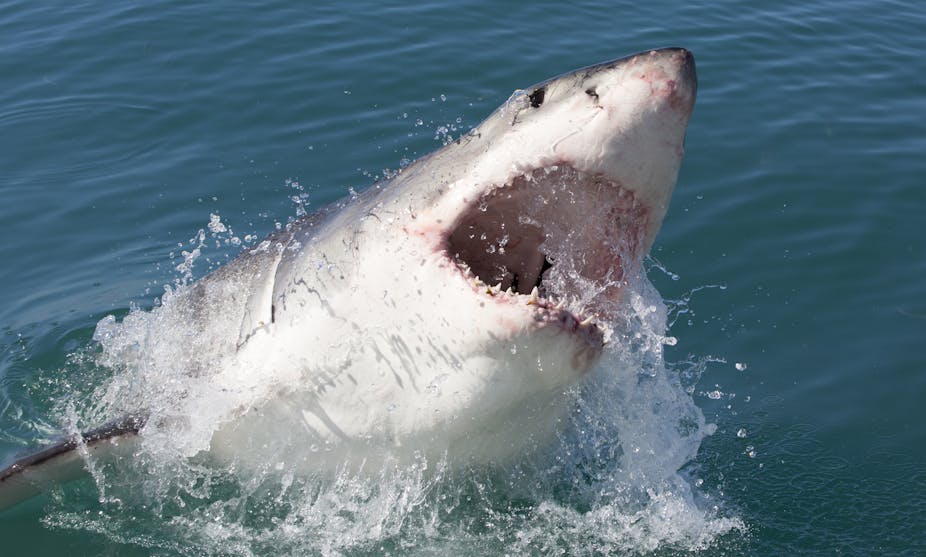The mathematics of shark bites look pretty simple: the more incidents, the worse the situation. That said, no amount of scientific explanation can fully address the tragedy of people being injured or killed by sharks.
Western Australia is currently dealing with such a situation. After a decade with few shark fatalities, seven people have now lost their lives in the past three years, prompting the state government to endorse using baited drumlines near popular beaches. The terrible numbers appear to speak for themselves. But there is an important problem that the public should know about when looking at these data.
The problem is that shark bite numbers can lie.
They lie in three ways. First, shark bites are discrete, random events that do not look random. Second, clusters of shark bite incidents are misleading. And third, we only count when human-shark interactions occur, not when they don’t. These points do not make these tragic situations any better but they can help in understanding how government policies can make them worse. And if governments are going to spend money on the problem, they need to be able to prove to the public that it will actually help.
Random events
Shark bites fall into a special statistical category known as “random, independent events”. This means that the likelihood that a shark bite will happen at a given time and place does not depend on when or where the last one happened. Just like a like a coin toss, if you get heads on the first time, you still only have a 50-50 chance of heads on the next flip.
Yet shark bites often do not look independent or random. Their nature makes them look like intent-based incidents. Any increase in frequency can also look like part of a new pattern, despite these events being independent, random and rare. As a result, the public understandably wants these vivid and frightening incidents stopped, and the government wants to diagnose a problem so it can come up with a solution.
It can be troubling for politicians and society to think of traumatic shark bites as random, unexplained events in nature - especially when they appear to come in clusters.
The impossibly hard situations following shark bites are made harder because beach-side communities can go through long periods of relative calm followed by a short spate of tragic deaths. This scene repeats itself around the world in other places like Hawaii and Reunion Island. But these clusters are misleading, and the coin-flip analogy helps to show why.
There may be times when you flip a coin and get five tails in a row. This doesn’t mean the odds have changed; sometimes these clusters just happen. Statisticians call them “Poisson bursts”, and this distribution was discovered after an analysis by Ladislaus Bortkiewicz in 1898 that included a review of a sudden spate of deaths among Prussian soldiers, all from the same unit, who were kicked by horses.
The late shark biologist Aiden Martin noticed that shark bites follow the same pattern. “They can seem to occur in clusters… but the likelihood of any one individual being attacked by a shark at a given time and place and the average interval between any two attacks remains constant,” he wrote.
Challenging thinking
In other words, the odds of having one shark bite incident followed by none for three months are the same as having a group of them occur. Yet when a cluster does happen, the inclination is to look for some new factor that explains the apparent trend.
A cluster of shark bites in Florida in 2001 provides a good example. As Pennsylvania State University mathematician David Kelton commented at the time: “It really does seem that there is indeed something odd going on with the ocean currents, temperatures, food supply, or water chemistry. However, even if such attacks were purely ‘random’ and independent of each other, it is not surprising that they seem to occur in ‘clumps’… and then not at all for a long time.”
This suggests that we should revise our traditional thinking about clusters of shark bites. In the 1950s, some people held the view that one lone shark, intent on biting people, was responsible for all shark bites in a region and that hunting this “rogue” shark was the answer. But a more deliberative analysis leads us to the view that shark bite clusters are statistical accidents of nature. Or put another way, I often tell people that “we’re in the way, not on the menu”.
For another angle, look at it the other way around: there are thousands of times when humans and sharks share the water and bites don’t occur - including, according to a 2009 New South Wales government report, those months when sharks migrate in their highest numbers along the coast. The coin is tossed all the time, but we only count the tragedies.
A word to Western Australia
Shark bites are random events but they are not perceived that way. Clusters make it look like we need to take action to stop a threat, such as the WA government’s new culling policy. But equally, the long gaps between clusters of shark bites could statistically make it look like a policy has succeeded even if it has no effect at all on the underlying risk of a bite.
As a result, the WA government has a duty to demonstrate to the public how its policies will genuinely safeguard them - particularly when the policy will harm ecosystems, as scientists suggest WA’s drumlines are likely to do. Presently, it is far from clear what effect the drumlines will have on public safety.
Shark bites are tragedies for families and communities, and very difficult for politicians. Reacting to these events is not easy, but numbers alone can tell a false story, or even lie. Approaching them with eyes wide open and a grain of salt can help with public education and public policies.

